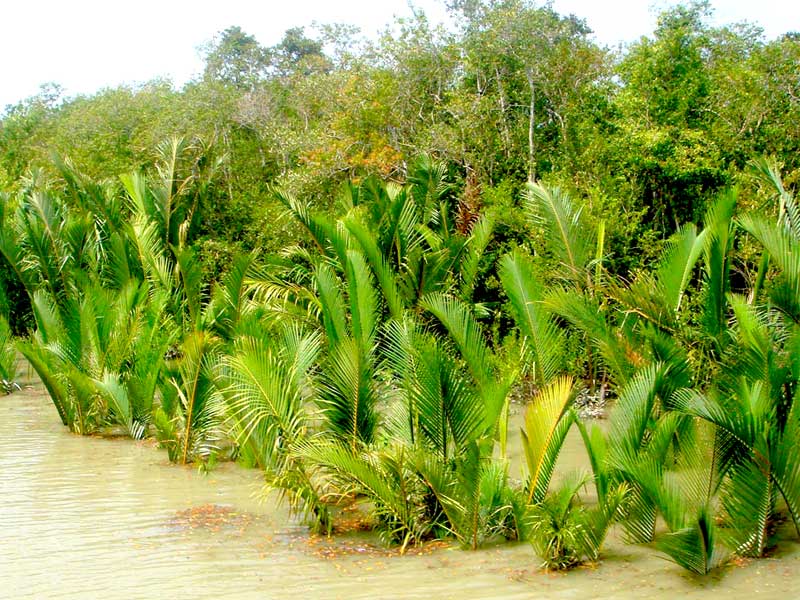The
Sundarbans is a natural region in Bengal. It is the largest single block of
tidal halophytic mangrove forest in the world. The Sundarbans covers
approximately 10,000 square kilometers (3,900 sq mi) of which 60 percent is in
Bangladesh with the remainder in India. The Sundarbans is a UNESCO World
Heritage Site.
The
Sundarbans National Park is a National Park, Tiger Reserve, and a Biosphere
Reserve located in the Sundarbans delta in the Indian state of West Bengal.
Sundarbans South, East and West are three protected forests in Bangladesh. This
region is densely covered by mangrove forests, and is one of the largest
reserves for the Bengal tiger. The history of the area can be traced back to
200–300 AD. A ruin of a city built by Chand Sadagar has been found in the
Baghmara Forest Block. During the Mughal period, the Mughal Kings leased the
forests of the Sundarbans to nearby residents. Many criminals took refuge in
the Sundarbans from the advancing armies of Emperor Akbar.
Many have been known
to be attacked by tigers. Many of the buildings which were built by them later
fell to hands of Portuguese pirates, salt smugglers and dacoits in the 17th
century. Evidence of the fact can be traced from the ruins at Netidhopani and
other places scattered all over Sundarbans. The legal status of the forests
underwent a series of changes, including the distinction of being the first
mangrove forest in the world to be brought under scientific management. The
area was mapped first in Persian, by the Surveyor General as early as 1764
following soon after proprietary rights were obtained from the Mughal Emperor
Alamgir II by the British East India Company in 1757. Systematic management of
this forest tract started in the 1860s after the establishment of a Forest
Department in the Province of Bengal, in British India. The management was
entirely designed to extract whatever treasures were available, but labor and
lower management mostly were staffed by locals, as the British had no expertise
or adaptation experience in mangrove forests.
The
first Forest Management Division to have jurisdiction over the Sundarbans was
established in 1869. In 1875 a large portion of the mangrove forests was
declared as reserved forests under the Forest Act, 1865 (Act VIII of 1865). The
remaining portions of the forests were declared a reserve forest the following
year and the forest, which was so far administered by the civil administration
district, was placed under the control of the Forest Department. A Forest
Division, which is the basic forest management and administration unit, was
created in 1879 with the headquarters in Khulna, Bangladesh. The first
management plan was written for the period 1893–98.
In
1911, it was not described as a tract of waste country which had never been
surveyed, nor had the census been extended to it. It then stretched for about
266 kilometers (165 mi) from the mouth of the Hugli to the mouth of the Meghna
River and was bordered inland by the three settled districts of the 24
Parganas, Khulna and Bakerganj. The total area (including water) was estimated
at 16,900 square kilometers (6,526 sq mi). It was a water-logged jungle, in
which tigers and other wild beasts abounded. Attempts at reclamation had not
been very successful. The Sundarbans was everywhere intersected by river
channels and creeks, some of which afforded water communication throughout the
Bengal region both for steamers and for native boats.
The
Sundarban forest lies in the vast delta on the Bay of Bengal formed by the
super confluence of the Padma, Brahmaputra and Meghna rivers across southern
Bangladesh. The seasonally flooded Sundarbans freshwater swamp forests lie
inland from the mangrove forests on the coastal fringe. The forest covers
10,000 square kilometers (3,900 sq mi) of which about 6,000 square kilometers
(2,300 sq mi) are in Bangladesh. It became inscribed as a UNESCO world heritage
site in 1997. The Indian part of Sundarbans is estimated to be about 4,110
square kilometers (1,590 sq mi), of which about 1,700 square kilometers (660 sq
mi) is occupied by water bodies in the forms of river, canals and creeks of
width varying from a few meters to several kilometers.
The
Sundarbans is intersected by a complex network of tidal waterways, mudflats and
small islands of salt-tolerant mangrove forests. The interconnected network of
waterways makes almost every corner of the forest accessible by boat. The area
is known for the eponymous Royal Bengal tiger (Panthera tigris tigris), as well
as numerous fauna including species of birds, spotted deer, crocodiles and
snakes. The fertile soils of the delta have been subject to intensive human use
for centuries, and the eco region has been mostly converted to intensive
agriculture, with few enclaves of forest remaining. The remaining forests,
taken together with the Sundarbans mangroves, are important habitat for the
endangered tiger. Additionally, the Sundarbans serves a crucial function as a
protective barrier for the millions of inhabitants in and around Khulna and
Mongla against the floods that result from the cyclones. The Sundarbans has
also been enlisted among the finalists in the New7Wonders of Nature.
 RSS Feed
RSS Feed Twitter
Twitter 06:07
06:07
 Unknown
Unknown



 Posted in
Posted in
0 comments:
Post a Comment